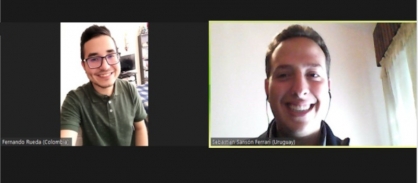A gathering of friends through a WhatsApp video call, a chat on Google Meet, classes by Microsoft Teams, a coffee in the "Facebook rooms" and a party by Zoom. These are some virtual activities of our last weeks, during this period of confinement (obligatory or voluntary) due to the coronavirus pandemic. The modality of our meetings changed considerably and, in this context, we reached a formidable discovery: we were not graced with the gift of bilocation, but we are developing digital omnipresence. This concept refers to the ability to be in two or more digital activities at the same time. In the following lines we propose to explore some theoretical background, break down the advantages and disadvantages that we detect in digital omnipresence from our experience. Finally, we will outline some suggestions for managing this issue in the coming months or as long as the restrictions imposed by the health emergency last.
Communication is sharing, it is the shared construction of meanings. There are always values in it. Communication is mutual human understanding and is linked to experience, a project, a common action. In it, the relationship between people is more important than the information itself. As always, being (in relation to others) is more valuable than having (information).
Today we realize that we can interact simultaneously on different platforms at the same time, from the same place, connected from different time zones. We have to recognize that behind the screens there are real people, with feelings; that each emoji and sticker we send represents our state of mind, that each tweet we share reflects our thoughts, that relationships are woven through a digital environment.
We see with greater precision the enormous gap that exists in access to the Internet and the use / acquisition of technological devices, we also recognize that access to Information Technologies is not a privilege, it is a basic need for humanity (Cfr. United Nations Iot).
A little corner from where we give signs of life to the world
Opening up to the media - digital - is not an option, it is a real necessity for the mission. Digital thinking is faster, parallel, shorter, interactive, collective, multimedia, iconic. It involves brain changes. For this reason, to announce the Gospel today is to communicate its message to people with these characteristics.
"The fascination with the media and the fear of entering the world of communication" has been a focus of discussion in the communities. We know that there are many risks in the network, but we have to take them courageously; We have to opt for the spirituality of technology, that manages to 'communicate our life and announce the truth' ”(Bolivian Conference of Religious).
In digital communities, we are ephemeral groups, with relative permanence: the network with its multiplicity of connections and ways to travel to trace new and possible routes, choose different stories and narratives. From the ephemeral nature of network relationships, one can choose to build a community, with cohesion and solidarity, reciprocal listening and dialogue, and the responsible use of language. A network is codependent, hypertextual, complex, it has no centrality, it is dynamic at its extremes. It is one of the most dynamic and malleable structural organisms.
Online and offline mode
Referring to being and being, the “reality of flesh and blood”, we consider the importance of taking care of mental health, taking daily breaks and creating a routine with schedules that allow us to establish when and how to stop.
Holding on to a screen
We undoubtedly experience a hyperconnection, because the first thing we do when we wake up and the last thing before going to sleep is to turn on / off a technological device, certainly an online lifestyle, which even affects interpersonal relationships with the same family members with that we live in the same house or apartment. We even share more with others who are physically away from us than with those who are in our homes.
The only window to the world
We attended an oversupply, we are saturated by the thousands of stimuli that we receive daily to our emails, hundreds and hundreds of WhatsApp chats and millions of notifications on all social networks. Before we complained because the bus left us or because the weather simply did not match our outfit, now we exclaim frequently, when the Internet connection is intermittent, when a technological device does not advance at the speed we want or even if someone we need urgently does not respond.
Digital toxicity
Surely our hands hurt frequently, our eyes are dry or our spine is paralyzed. Therefore, we propose to create your own personal communication plan that can cover the following points:
Prioritize your activities.
Define which communication channels (national, international) you want to tune in and in what format: radio-auditory.
Organize the websites of official institutions.
Structure the hours you will enter.
Avoid circulating false information (fake news) and break the chains of disinformation.







